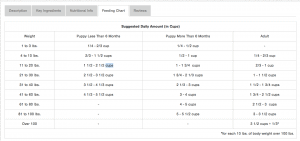De-Mystifying LIFE STAGE dog foods: Should you feed it to your Lab?
 According to Cathleen Enright, PH.D., president and CEO of Pet Food Institute in Washington, DC, significant advancements in companion animal nutritional science have been made in the last 50 years. The first “Life Stage” food appeared in the 1960’s and the National Academy of Sciences’ National Research Council updated the nutrient profiles for dogs and cats to include physical activity and multiple life-stages food.
According to Cathleen Enright, PH.D., president and CEO of Pet Food Institute in Washington, DC, significant advancements in companion animal nutritional science have been made in the last 50 years. The first “Life Stage” food appeared in the 1960’s and the National Academy of Sciences’ National Research Council updated the nutrient profiles for dogs and cats to include physical activity and multiple life-stages food.
Most Americans consider their dog to be a family member, so continued investment and study in nutritional science means that pet food makers are now able to provide a number of options for pet lovers to feel confident in meeting their dog’s nutritional needs.
Many companies will offer choices for “Large Breed” puppies, for instance. Taking into consideration the nutritional needs of this particular type of dog, pet food companies are helping provide better nutritional guidelines for these targeted foods. For instance, a large breed dog needs to grow more slowly as there is more stress put on their joints than a toy breed, so the food is formulated to reflect this need. Some companies divide their foods into “medium sized dog” food, as well, and note a weight range for those particular formulas. Also, be sure your food has a weight chart on their bag showing, by weight AND by life stage, how much should be fed. For instance:
Life’s Abundance “All Life Stages” (appropriate for puppies and adults) has a label that looks like this:
(Chart is divided into “puppies less than 6 months, puppies over 6 months, and adults–by weight)–sorry, I could not get a good photo.
I consider Labradors to be a “medium sized breed,” as would the AKC. Large breed puppy food would be appropriate for a Great Dane, Newfoundland, or dogs over 100-150 lbs, but not for a Labrador (65-90 lbs). Personally, I also don’t like feeding a “puppy” food as it contains too much protein and calories, and Labs are very prone to being overweight, thereby putting undue strain on their joints. With Hip and Elbow Dysplasia being prevalent in the breed, this is another easy I like to keep my dogs leaner (even if they have OFA Excellent or Good on their hips and elbows) I also feel that the protein in puppy food can make them hyper, so I just stay away from it after 6 weeks of age.
Be sure your food has been considered “complete and balanced” by AAFCO requirements. (Life’s Abundance foods, I’ve learned EXCEED AAFCO requirements) Also, be sure to check with your breeder as to what food she has found good results within her breed or his particular bloodlines. That is always the best bet. And since most breeders have been students of canine nutrition for over 20-30 years, their insight can trump the experience of most veterinarians who only get a few hours of education of nutrition in vet school. Most of what they learn comes from pet food sales reps. Many times they don’t have the time to keep up with the latest trends or research in this area as their expertise generally leans towards diagnosis, pharmaceuticals, and surgery.
A responsible breeder will also have bred their dogs to not have a genetic disposition to allergies, but also realize the new pet parents can reverse all of their hard work by feeding and inferior food, thereby causing allergic symptoms merely caused by improper (cheap) nutritional requirements. Nine times out of ten, when I do online nutritional counseling, I find that symptoms presented to me are quickly and simply reversed when a good quality, appropriate, species-appropriate food is applied.
Learn more about high-quality foods:








5 Comments